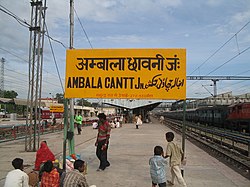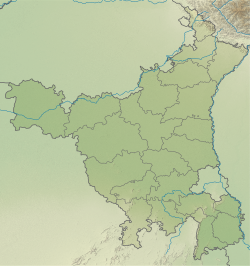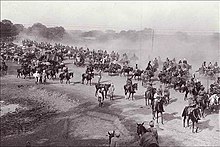| This article needs additional citations for verification. Please help improve this article by adding citations to reliable sources. Unsourced material may be challenged and removed. Find sources: "Ambala" – news · newspapers · books · scholar · JSTOR (December 2011) (Learn how and when to remove this message) |
City in Haryana, India
| Ambala | |
|---|---|
| City | |
 Ambala Cantonment Railway Station, Haryana, India Ambala Cantonment Railway Station, Haryana, India | |
  | |
| Coordinates: 30°23′N 76°47′E / 30.38°N 76.78°E / 30.38; 76.78 | |
| Country | |
| State | Haryana |
| District | Ambala |
| Established | 14th century CE |
| Founded by | Amba Rajput |
| Named for | Amba Rajput, Bhawani Amba (Goddess) |
| Government | |
| • Type | Municipal Corporation |
| • Body | Ambala Municipal Corporation |
| Elevation | 264 m (866 ft) |
| Population | |
| • Total | 207,934 (UA) |
| Demonym | Ambalvi |
| Languages | |
| • Official | Hindi |
| • Additional official | English, Punjabi |
| • Regional | Haryanvi |
| Time zone | UTC+5:30 (IST) |
| PIN | 1330xx,1340xx |
| Telephone code | 0171 |
| ISO 3166 code | IN-HR |
| Vehicle registration | HR 01 (city), HR 04 (Naraingarh), HR 54 (Barara), HR 85 (Ambala Cantonment), HR37 (commercial) |
| Website | ambala |

Ambala (/əmˈbɑːlə/) is a city and a municipal corporation in Ambala district in the state of Haryana, India, located on the border with the Indian state of Punjab and in proximity to both states capital Chandigarh. Politically, Ambala has two sub-areas: Ambala Cantonment (also known as Ambala Cantt) and Ambala City, eight kilometres apart, therefore, it is also known as "Twin City." It has a large Indian Army and Indian Air Force presence within its cantonment area. It is located 200 km (124 mi) to the north of New Delhi, India's capital, and has been identified as a counter-magnet city for the National Capital Region to develop as an alternative center of growth to Delhi.
Ambala separates the Ganges river network from the Indus river network and is surrounded by two rivers – Ghaggar and Tangri – to the north and to the south. Due to its geographical location, the Ambala district plays an important role in local tourism, being located 47 km (29 mi) south of Chandigarh, 50 km (31 mi) north of Kurukshetra, 148 km (92 mi) southwest of Shimla, 198 km (123 mi) north of New Delhi and 260 km (160 mi) southeast of Amritsar.
History
See also: History of Haryana and Tourism in HaryanaEtymology
The town is said to derive its name from Amba Rajput who supposedly founded it during the 14th century CE. According to another version, it is named after the goddess "Bhawani Amba," whose Temple still exists in Ambala city. The English spelling Umballa has sometimes been used; this spelling was used by Rudyard Kipling in his 1901 novel Kim.
Classical era
Archaeological Surveyor C.J Rodgers found Indo-Parthian Kingdom coins as well as coins of Hunas, Mihirakula and Toramana which indicated that after the disintegration of the Mauryan empire, the area was taken over by Indo-Parthians and later incorporated into the domain of the Hunas.
Late medieval era
In 1709, Battle of Ambala was fought, and Sikhs captured Ambala from Mughals. It was under the rule of Gill Jats from 1748 to 1825. It was also the capital of Nishanwalia Misl. For some time it had been under the rule of Jawahir Singh of Mustafabad, a descendant of Desu Singh Randhawa.
British colonial era
The Ambala Cantonment

Ambala Army Base
Ambala Army Cantonment was established in 1843 after the British were forced to leave its Karnal Cantonment following the malaria epidemic of 1841–42 in as there were not any known effective means to control malaria epidemic in those days. The cantonment houses the '2 Corps', one of the three Strike Corps of the Indian Army.
Ambala Air Force Base
Ambala Air Force Base is one of the oldest and largest airbases that were inherited from the British by the IAF. It was from this airbase that Spitfires and Harvards flown by Instructors of the Advanced Flying Training School took part in the Indo-Pakistani War of 1947–1948. Subsequently, Ambala was the front line airfield for many years. It was home to various aircraft that were inducted into the Indian Air Force. Vampires, Ouragans, Hunters, etc. all flew from this base. The airbase was briefly attacked in 1965 by B-57 bombers of the Pakistan Air Force. Today, the Airbase houses the '7 Wing' with squadrons of Jaguars and MiG-21 Bisons. A unit of the French-made Dassault Rafale will also be based at Ambala airbase.
European Cemetery
Ambala Cantonment is the location of historic European Cemetery. It is 200 km north of Delhi and 55 km southwest of Chandigarh.
1857 War Memorial
See also: Bengal Native Infantry in aftermath of 1857
First War of Independence Memorial or 1857 War Memorial, completed in 2023 at the cost of Rs300 crore in the honour of Indian rebels of 1857 First War of Independence, is spread over 22 acres on NH-44. The war was started at Ambala on 10 May 1857 by the Indian sepoys of 5th & 60th regiments of Bengal Native Infantry stationed at Ambala Cantonment. After the war was over, the execution of Baba Mohar Singh on 5 June 1857 at Ambala Cantonment was the first recorded execution of a captured Indian rebel by the British colonial regime. Ambala rebellion was led by Ananti Mishra, Parmeshwar Pandey, Beni Prasad, Sheikh Faiz Ul-Khan, Bikhan Khan who moved towards Red Fort in Delhi via Bilaspur, Sadhaura, Yamunanagar and Saharanpur. After the war was over, the British authorities burnt the villages of Bilaspur and Sadhaura as punishment for providing aid to the rebels. The 5th & 60th Regiments of the Bengal Native Infantry were also disbanded. The memorial has four sections, an administrative building, second a museum building, third a library and food court, and the fourth is an open air theatre.
Formation of Ambala district
Ambala was given the status of a district in 1847, formed by the merging of the jagir estates of hitherto independent chieftains whose territories had lapsed or had been confiscated by the British Indian Government. In its 160 years of existence as a district, Ambala has witnessed many changes in its boundaries. Previously, it extended across tehsils of Ambala, Chandigarh, Jagadhri, Pipli, Kharar, Ropar and Nalagarh. Kalka-cum-Kurari State, Pinjore, Mani Majra, Kasauli & Sanawar were also merged later into the district at different times.
1857 rebellion
See also: Haryana in 1857, Ballabhgarh history, Farrukhnagar history, Nahar Singh, and Rao Tula RamFor their participation in first war of independence, the Chaudharys and Lambardars of villages who participated in rebellion were also deprived of their land and property, including 368 people of Hisar and Gurugram were hanged or transported for life, and fine was imposed on the people of Thanesar (Rs 235,000), Ambala (Rs. 253,541) and Rohtak (Rs. 63,000 mostly on Ranghars, Shaikhs and Muslim Kasai).
Post-independence
Hanging of Nathuram Godse
In November 1949, Mahatma Gandhi's assassin Nathuram Godse was hanged at Ambala Central Jail along with Narayan Apte, a co-conspirator.
Geography
Climate
The climate is a humid subtropical climate (Koppen: Cwa), with the monsoon season being noticeably rainier than the rest of the year, along with being much hotter and more humid than the winter, which is mild/cold and dry.
| Climate data for Ambala (1991–2020, extremes 1901–2012) | |||||||||||||
|---|---|---|---|---|---|---|---|---|---|---|---|---|---|
| Month | Jan | Feb | Mar | Apr | May | Jun | Jul | Aug | Sep | Oct | Nov | Dec | Year |
| Record high °C (°F) | 29.1 (84.4) |
33.9 (93.0) |
41.7 (107.1) |
45.0 (113.0) |
47.8 (118.0) |
47.8 (118.0) |
46.7 (116.1) |
43.9 (111.0) |
40.6 (105.1) |
39.4 (102.9) |
35.6 (96.1) |
29.4 (84.9) |
47.8 (118.0) |
| Mean daily maximum °C (°F) | 18.1 (64.6) |
22.5 (72.5) |
27.7 (81.9) |
35.1 (95.2) |
38.4 (101.1) |
37.9 (100.2) |
34.5 (94.1) |
33.5 (92.3) |
33.1 (91.6) |
31.7 (89.1) |
26.9 (80.4) |
21.0 (69.8) |
30.0 (86.0) |
| Mean daily minimum °C (°F) | 6.7 (44.1) |
9.6 (49.3) |
14.3 (57.7) |
19.6 (67.3) |
23.8 (74.8) |
25.5 (77.9) |
25.7 (78.3) |
25.1 (77.2) |
23.3 (73.9) |
17.8 (64.0) |
11.8 (53.2) |
7.5 (45.5) |
17.5 (63.5) |
| Record low °C (°F) | −1.3 (29.7) |
−0.6 (30.9) |
3.7 (38.7) |
9.4 (48.9) |
13.9 (57.0) |
17.8 (64.0) |
19.4 (66.9) |
20.0 (68.0) |
15.6 (60.1) |
8.3 (46.9) |
1.8 (35.2) |
−0.6 (30.9) |
−1.3 (29.7) |
| Average rainfall mm (inches) | 30.7 (1.21) |
35.9 (1.41) |
29.4 (1.16) |
20.1 (0.79) |
35.3 (1.39) |
111.4 (4.39) |
257.0 (10.12) |
228.0 (8.98) |
136.5 (5.37) |
14.3 (0.56) |
6.5 (0.26) |
15.4 (0.61) |
920.5 (36.24) |
| Average rainy days | 2.0 | 2.4 | 2.0 | 1.7 | 3.0 | 5.5 | 8.7 | 8.9 | 5.5 | 0.8 | 0.4 | 0.8 | 41.7 |
| Average relative humidity (%) (at 17:30 IST) | 66 | 55 | 45 | 29 | 30 | 44 | 68 | 72 | 66 | 52 | 53 | 63 | 53 |
| Source: India Meteorological Department | |||||||||||||
Demographics
| Religion in Ambala city | ||||
|---|---|---|---|---|
| Religion | Percent | |||
| Hinduism | 81.94% | |||
| Sikhism | 14.59% | |||
| Jainism | 1.44% | |||
| Islam | 1.25% | |||
| Others | 0.78% | |||
As of 2011 India census, Ambala UA had a population of 207,934 consisting of 112,840 males and 95,094 females, a ratio of 843. There were 20,687 children 0–6 and Ambala had an average literacy rate of 89.31%, with 91.76% of males and 86.41% of females literate.
| Religious group |
1868 | 1881 | 1891 | 1901 | 1911 | 1921 | 1931 | 1941 | 2011 | |||||||||
|---|---|---|---|---|---|---|---|---|---|---|---|---|---|---|---|---|---|---|
| Pop. | % | Pop. | % | Pop. | % | Pop. | % | Pop. | % | Pop. | % | Pop. | % | Pop. | % | Pop. | % | |
| Hinduism |
27,008 | 53.27% | 34,522 | 51.17% | 40,339 | 50.87% | 39,601 | 50.36% | 38,192 | 47.66% | 37,765 | 49.48% | 39,945 | 46.13% | 50,679 | 47.19% | 159,912 | 81.94% |
| Islam |
19,570 | 38.6% | 27,115 | 40.19% | 30,523 | 38.49% | 32,149 | 40.88% | 31,641 | 39.49% | 31,448 | 41.2% | 38,089 | 43.99% | 47,881 | 44.59% | 2,431 | 1.25% |
| Christianity |
1,362 | 2.69% | — | — | 4,899 | 6.18% | 3,610 | 4.59% | 5,918 | 7.39% | 2,373 | 3.11% | 3,138 | 3.62% | 1,054 | 0.98% | 739 | 0.38% |
| Sikhism |
1,235 | 2.44% | 1,867 | 2.77% | 2,407 | 3.04% | 2,168 | 2.76% | 3,392 | 4.23% | 3,622 | 4.75% | 4,143 | 4.78% | 4,926 | 4.59% | 28,471 | 14.59% |
| Jainism |
— | — | 410 | 0.61% | 1,119 | 1.41% | 1,096 | 1.39% | 957 | 1.19% | 1,083 | 1.42% | 1,269 | 1.47% | 1,814 | 1.69% | 2,816 | 1.44% |
| Zoroastrianism |
— | — | — | — | 6 | 0.01% | 14 | 0.02% | 31 | 0.04% | 30 | 0.04% | 2 | 0% | — | — | — | — |
| Buddhism |
— | — | — | — | 0 | 0% | 0 | 0% | 0 | 0% | 5 | 0.01% | 5 | 0.01% | — | — | 55 | 0.03% |
| Judaism |
— | — | — | — | 0 | 0% | N/A | N/A | 0 | 0% | 0 | 0% | 1 | 0% | — | — | — | — |
| Others | 1,521 | 3% | 3,549 | 5.26% | 1 | 0% | 0 | 0% | 0 | 0% | 0 | 0% | 0 | 0% | 1,008 | 0.94% | 729 | 0.37% |
| Total population | 50,696 | 100% | 67,463 | 100% | 79,294 | 100% | 78,638 | 100% | 80,131 | 100% | 76,326 | 100% | 86,592 | 100% | 107,383 | 100% | 195,153 | 100% |
Economy
Cloth Market
The Cloth Market is considered to be the largest textile market in this region. The market is known for catering to wedding related shopping. The most commonly bought items are sarees and silk clothing.
Transport
Ambala is connected to all of the other major cities of north India. It is a big interchange for various commuters for all neighbouring states.
National Highway NH 44 popularly known as GT road earlier known as NH 1 passes through Ambala and connects it to National capital Delhi, Panipat, Ludhiana and Amritsar. NH 152 connects it to state capital Chandigarh, Kaithal. Apart from the Interstate service, Ambala also houses one of the oldest local bus services in Haryana, which is run by both Haryana roadways and private companies. Other means of local transportation include auto rickshaws and cycle rickshaws.
Roadways
Bus service is the major means of public transport in this district. Ambala depot came into being on 1 August 1950. The office of the General Manager has situated on the premises of the depot workshop at Ambala City. Ambala depot has a sub depot at Naraingarh.
Presently, Haryana Roadways, Ambala has 200 buses, which carry about 34.88 Lac's passengers daily and cover a distance of about 19000 km daily. Out of these, total distance covered on interstate routes is 24,711 km (15,355 mi) and 41.469 km (25.768 mi) are operated within Haryana every day.
New Bus Stand at Ambala Cantt was inaugurated on 12 July 1999 and the total land of bus stand is 6.7 acres (2.7 ha). Bus stands in this district exist at Ambala City, Naraingarh and Barara as well. A sub-depot-level workshop has also been provided at Naraingarh. 'Yatri Niwas' exists on the campus of Ambala Cantt. bus stand for the convenience of the commuters who wish to stay for the night.
Besides, the Haryana Roadways buses, the government has issued permits to private operators on local routes. Presently 60 such buses are plying in Ambala district. The bus stand is very near to Ambala Cantt Jn. (Railway station). Most of the buses plying on GT road (NH1) stop in front of the Railway station.
Railways
Ambala is a divisional headquarters of the Northern Railway Zone and is an important railway junction. Ambala Cantt station is among the top 100 booking stations in India. The city is served by three railway stations:
- Ambala Cantt (Junction on Delhi-Kalka line and Moradabad-Ambala line/Ambala-Attari line)
- Ambala City (On Ambala-Attari line)
- Dhulkot (on Delhi-Kalka line)
The Ambala Cantonment railway station was founded on the junction of the Delhi-Kalka and Ludhiana-Saharanpur lines. The historic Delhi-Panipat-Ambala-Kalka railway line dates back to 1889 while the Ludhiana-Saharanpur line was built in 1870. Situated 200 km (120 mi) north of Delhi, this town is well connected by the rail and road network.
Ambala cantt railway station is main station of the city and is well connected with major cities of India. Kalka-Shimla Railway, which is a UNESCO World Heritage site, also comes under Ambala division.
Ambala Cantonment railway station serves maximum Shatabdi Express after New Delhi. Ambala railway station was mentioned in the famous story 'The Woman on Platform 8' by Ruskin Bond, although in reality there is no platform 8 in Ambala Cantt.
Education
Ambala has a large number of schools and colleges. Notable colleges are as follows:
- Convent of Jesus and Mary, Ambala
- D.A.V. College (Lahore), Ambala City
- E-Max School of Engineering and Applied Research
- Government Polytechnic College, Ambala
- Maharishi Markandeshwar University, Mullana
- Maharishi Markandeshwar University, Sadopur
- Philadelphia Hospital & School of Nursing, Ambala
- Sanatan Dharma College (S.D. College)
- Shri Atmanand Jain Institute of Management and Technology
Notable people

- Zohrabai Ambalewali
- Hansraj Behl
- Urvashi Butalia
- Simi Chahal
- Juhi Chawla
- Parineeti Chopra
- Swadesh Deepak
- Navneet Kaur Dhillon
- Sanjeev Kapoor
- Manpreet Kaur
- Nasir Kazmi
- Sucheta Kripalani
- Shalabh Kumar
- Selja Kumari
- Talib Dehlavi
- Kim Philby
- Ash K. Prakash
- Om Puri
- Saghar Siddiqui
- Sanjiv Sam Gambhir
- Sushma Swaraj
- Zeba
Notes
- 1868-1941: Data for the entirety of the town of Ambala, which included Ambala Municipality, Ambala Civil Lines, Sadar Bazar Ambala Municipality, and Ambala Cantonment.
- ^ 1931-1941: Including Ad-Dharmis
References
- ^ "Urban Agglomerations/Cities having population 1 lakh and above" (PDF). Census India. Retrieved 29 December 2015.
- "Ambala Municipal Corporation". June 2024.
- "Report of the Commissioner for linguistic minorities: 52nd report (July 2014 to June 2015)" (PDF). Commissioner for Linguistic Minorities, Ministry of Minority Affairs, Government of India. p. 24. Archived from the original (PDF) on 15 November 2016. Retrieved 4 February 2019.
- IANS (28 January 2010). "Haryana grants second language status to Punjabi". Hindustan Times. Retrieved 2 January 2019.
- "Haryanvi". Ethnologue. Archived from the original on 1 June 2016. Retrieved 20 February 2024.
- ^ Haryana Gazateer, Revenue Dept of Haryana, Capter-V.
- Bajwa, J.S.; Kaur, R. (2007). Tourism Management. APH Publishing Corporation. ISBN 9788131300473.
- "Bibliomania: Free Online Literature and Study Guides". Retrieved 2 December 2023.
- Sagoo, Harbans (2001). Banda Singh Bahadur and Sikh Sovereignty. Deep & Deep Publications.
- Siṅgha, Bhagata (1993). A History of the Sikh Misals. Publication Bureau, Punjabi University. Retrieved 30 May 2023.
- Singh, Khazan (1970). History of the Sikh Religion. Department of Languages, Punjab. Retrieved 30 May 2023.
- Sharma, Suresh K. (1 February 2006). "Haryana: Past and Present". Mittal Publications. ISBN 9788183240468. Retrieved 30 May 2023.
- ANI (4 January 2019). "Indian Air Force To Deploy Rafale Jets in Ambala, Hashimara". NDTV. Retrieved 10 March 2019.
- ^ Nagpal, Bhavey (12 May 2023). "Ambala's 1857 War Memorial likely to be opened by year end". Hindustan Times. Retrieved 8 July 2023.
- "Panel of historians meets to discuss 1857 memorial in Ambala". Times of India. 12 June 2022. Retrieved 8 July 2023.
- Satish Chandra Mittal, 1986, Haryana, a Historical Perspective, p58.
- The Times (London), page 3, 16 November 1949
- "Station: Ambala Climatological Table 1991–2020" (PDF). Climatological Normals 1991–2020. India Meteorological Department. Archived from the original (PDF) on 8 April 2024. Retrieved 7 July 2024.
- "Extremes of Temperature & Rainfall for Indian Stations (Up to 2012)" (PDF). India Meteorological Department. December 2016. p. M63. Archived from the original (PDF) on 5 February 2020. Retrieved 1 March 2020.
- "Ambala City Population Census 2011 – Haryana". www.census2011.co.in.
- ^ "CENSUS OF INDIA, 1941 VOLUME VI PUNJAB". Retrieved 17 January 2023.
- (India), Punjab (1868). "Report on the census of the Punjab taken on 10th January, 1868". p. 66. JSTOR saoa.crl.25057644. Retrieved 7 July 2024.
- "Census of India, 1881 Report on the Census of the Panjáb Taken on the 17th of February 1881, vol. I." 1881. JSTOR saoa.crl.25057656. Retrieved 14 January 2024.
- "Census of India, 1881 Report on the Census of the Panjáb Taken on the 17th of February 1881, vol. II". 1881. JSTOR saoa.crl.25057657. Retrieved 14 January 2024.
- "Census of India, 1891 General Tables British Provinces and Feudatory States Vol I". Retrieved 17 January 2023.
- "CENSUS OF INDIA, 1901 VOLUME I-A INDIA PART II-TABLES". Retrieved 17 January 2023.
- "CENSUS OF INDIA, 1911 VOLUME XIV PUNJAB PART II TABLES". Retrieved 17 January 2023.
- "CENSUS OF INDIA, 1921 VOLUME XV PUNJAB AND DELHI PART II TABLES". Retrieved 17 January 2023.
- "CENSUS OF INDIA, 1931 VOLUME XVII PUNJAB PART II TABLES". Retrieved 17 January 2023.
- "Ambala City Population Census 2011 – Haryana". www.census2011.co.in.
- "About Cloth Market". Yatra.com. Retrieved 22 June 2019.
- "How to Reach | District Ambala,Government of Haryana | India". Retrieved 4 September 2022.
External links
| Ambala district topics | ||
|---|---|---|
| Cities and towns |  | |
| Transport | ||
| Lok Sabha constituencies | ||